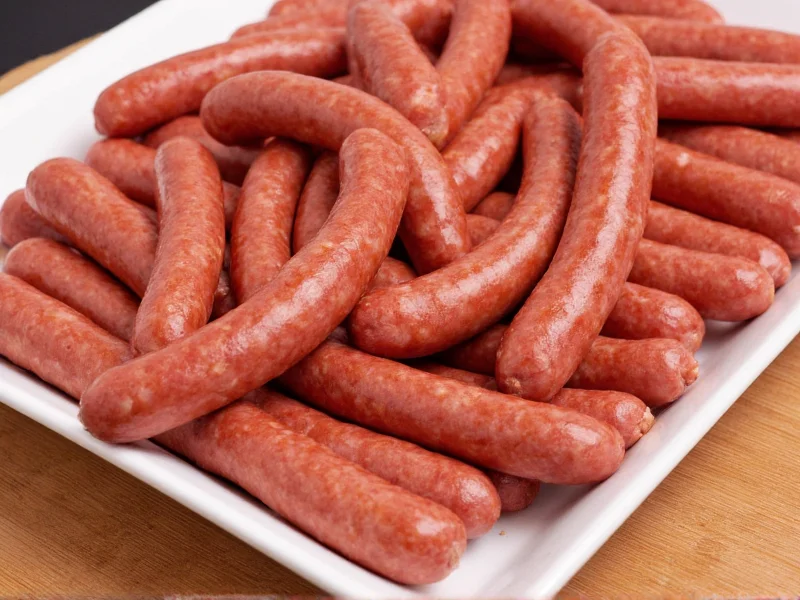Understanding whether is sausage processed meat requires examining how these popular food items are made. Processed meat refers to any meat that has been transformed through salting, curing, fermentation, smoking, or the addition of chemical preservatives to enhance flavor or improve preservation. Sausages universally undergo these processes, placing them firmly in the processed meat category.
What Defines Processed Meat?
The World Health Organization's International Agency for Research on Cancer (IARC) defines processed meat as “meat that has been transformed through salting, curing, fermentation, smoking, or other processes to enhance flavor or improve preservation.” This definition encompasses sausages regardless of their specific variety.
When evaluating why is sausage classified as processed meat, consider these standard processing elements:
- Salt and sodium-based preservatives for flavor and bacterial control
- Nitrites or nitrates to prevent botulism and maintain color
- Smoke flavoring or actual smoking processes
- Mechanical processing that alters the meat's natural structure
- Additional ingredients like fillers, binders, and flavor enhancers
How Sausage Manufacturing Qualifies as Processing
All traditional sausage production involves multiple processing steps that transform raw meat into the final product. Even artisanal sausages undergo fundamental processing:
- Grinding or mincing raw meat (altering its natural state)
- Mixing with salt, spices, and preservatives
- Stuffing into casings
- Additional preservation methods like smoking, drying, or cooking
The critical factor in what makes sausage a processed meat product is the intentional alteration of raw meat through preservation techniques and added substances—not merely the grinding process itself.
Sausage Types and Processing Levels
While all sausages qualify as processed meat, the degree of processing varies significantly. This distinction matters when considering health effects of eating processed sausage and making informed dietary choices.
| Sausage Type | Processing Level | Key Characteristics | Health Considerations |
|---|---|---|---|
| Pre-cooked sausages (hot dogs, bologna) | Highly processed | Emulsified, multiple additives, pre-cooked | Highest sodium and preservative content |
| Smoked sausages (kielbasa, andouille) | Moderately processed | Smoked, contains preservatives, often pre-cooked | Moderate sodium levels, smoke compounds |
| Fresh sausages (breakfast sausage, Italian) | Minimally processed | Raw, requires cooking, fewer additives | Lower sodium than pre-cooked varieties |
| Dry-cured sausages (salami, pepperoni) | Highly processed | Fermented, dried, high salt content | High sodium, but no cooking required |
Health Implications of Sausage Consumption
When researching is sausage considered processed meat from a health perspective, numerous studies provide important context. The IARC classifies processed meat as Group 1 carcinogen, meaning there's sufficient evidence that it can cause cancer, particularly colorectal cancer.
However, risk levels vary based on:
- Consumption frequency - occasional versus daily intake
- Portion sizes - reasonable servings versus excessive consumption
- Sausage composition - higher meat content versus high filler content
- Overall dietary pattern - balanced diet versus poor nutrition
Nutrition experts generally recommend treating sausage as an occasional food rather than a dietary staple. The American Institute for Cancer Research suggests limiting processed meat consumption to special occasions rather than regular meals.
Reading Sausage Labels for Better Choices
When examining how to identify less processed sausage options, scrutinize ingredient labels carefully. Look for these indicators of potentially better options:
- Shorter ingredient lists with recognizable components
- Absence of sodium nitrite or use of natural nitrate sources like celery powder
- Higher meat content (check percentage if provided)
- No artificial fillers or excessive binders
- Lower sodium content (under 400mg per serving)
Some specialty producers create sausages using traditional methods with minimal processing. These products typically cost more but offer a middle ground between complete avoidance and regular consumption of highly processed varieties.
Practical Recommendations for Sausage Consumers
Understanding that sausage is processed meat doesn't mean you must eliminate it entirely. Consider these practical approaches:
- Moderation - treat sausage as an occasional food rather than a regular protein source
- Balanced meals - pair sausage with vegetables and whole grains to create nutritionally balanced dishes
- Homemade alternatives - make your own sausage using quality meat and minimal additives
- Variety rotation - alternate sausage with other protein sources throughout the week
- Portion control - serve smaller portions alongside substantial vegetable components
For those concerned about difference between fresh sausage and processed sausage, remember that even fresh sausages (which require cooking) still qualify as processed due to the preservation methods and additives used in their production.











 浙公网安备
33010002000092号
浙公网安备
33010002000092号 浙B2-20120091-4
浙B2-20120091-4